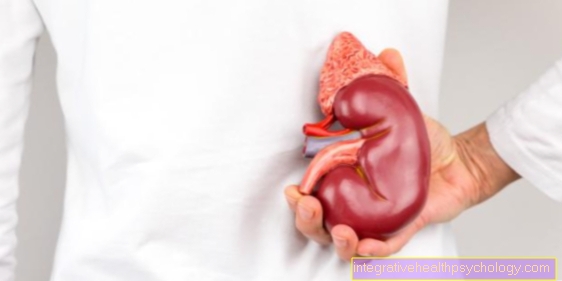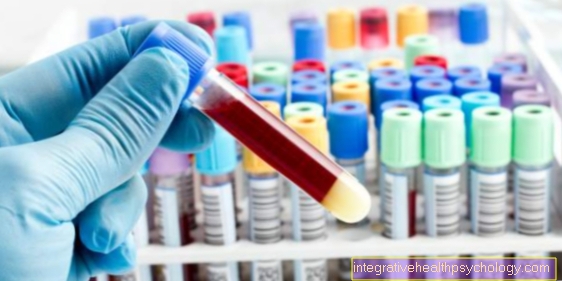Glandular fever in the child
introduction
Pfeiffer's glandular fever, technically as infectious mononucleosis is a viral disease that is transmitted by the Epstein-Barr virus (EBV). The virus particularly affects the lymphatic tissue, so that the lymph nodes, spleen and tonsils, which contain lymphoid tissue, are particularly affected.
Almost everyone (around 70%) comes into contact with this disease in the course of their life. The disease mostly occurs in children and adolescents. Since the disease is often transmitted in adolescents through kissing, it is also known as "kissing disease". Children are mostly affected between the ages of 4 and 15 years. In small children, transmission often takes place through kisses from the parents.

Symptoms of glandular fever in children
In children, the disease is usually mild, so that it is often not recognized as Pfeiffer's glandular fever, as only unspecific symptoms such as fatigue and fever occur.
In babies and toddlers in particular, the infection is more like a harmless viral infection and runs without any abnormalities. In some cases they have no symptoms at all.
The milder course of babies and toddlers is due to the fact that their immune system does not yet react as strongly to the virus as it does in older children. The characteristic appearance of Pfeiffer's glandular fever can already appear from kindergarten age.
However, this is more typical in adolescents and especially adults. They are often more affected and the disease lasts longer.
- Usually, EBV infection begins with common cold symptoms, such as a cough, runny nose, and sore throat.
- This is usually accompanied by a high fever and swelling of the lymph nodes in the neck.
- A tonsillitis and the accompanying severe sore throat and difficulty swallowing can often be associated with it. Characteristic white deposits on the tonsils and small bleeding on the palate then develop.
- Rarely does it come with a skin rash.
- Some patients may also have liver swelling.
- More often, however, there is a swelling of the spleen. Patients should definitely not do sports during this time, as there is a risk of the swollen spleen tearing and life-threatening rupture of the spleen.
- Liver swelling occurs in around 10% of cases, sometimes causing jaundice.
- In very rare cases, the central nervous system is also affected, which can lead to paralysis and inflammation in the brain and spinal cord membranes, which is why bed rest should always be observed in the acute phase of the disease.
Such a severe course is rather untypical in children. In most cases it is very mild and often asymptomatic. Usually it is mistaken for a harmless cold.
Read also: You can recognize Pfeiffer's glandular fever by these symptoms
Rash - a symptom of glandular fever in children?
In some cases, Pfeiffer's glandular fever can be accompanied by a rash. The rash is not a mandatory criterion for making the diagnosis, but it can manifest itself as part of the infection on different areas of the skin or throughout the body. If a rash does appear, it will most often show within the first 2-3 days of illness. The trunk of the body is often affected, but skin changes can also occur on the extremities, on the face or in the oral cavity and on the mucous membranes.
The rash resembles the skin changes in rubella infection. Small, reddish spots appear that combine and appear like a flat reddening that spreads from the face area over the whole body. In contrast to the typical rubella rash, a rash in the context of an infection with Pfeiffer's glandular fever is less pronounced. Usually only a few protrusions and reddening of the skin appear, which appear like a wheal and are accompanied by severe itching. To relieve the symptoms, the children can only be given fever and pain relieving medication and ensure that they are drinking enough fluids. The rash will go away on its own and without permanent skin damage.
Read more on the topic: Rash in a Pfeiffer's glandular fever
Treatment of glandular fever in children
No treatment is necessary if the infection is harmless. There is no specific therapy against the virus. If therapy is needed, then it is symptomatic therapy.
- It is important to keep bed rest.
- Furthermore, a thorough mouth cleaning should be carried out, as part of brushing your teeth and gargling.
- It is important that the child drinks a lot due to the fever and eats easily digestible food. The food should be easy to swallow because of the common tonsillitis.
- Cold drinks and ice cream can also alleviate the symptoms.
- Sour and spicy foods should be avoided as they irritate the mucous membrane.
- Homeopathic therapy can also provide relief.
Since antibiotics only work against bacteria and not against viruses, their use is pointless. Pfeiffer's glandular fever is sometimes confused with tonsillitis and then treated with antibiotics. If this treatment then takes place with an antibiotic from the group of aminopenicillins, a characteristic skin rash occurs in the presence of Pfeiffer's glandular fever.
Read more on the topic: Treatment of Pfeiffer's glandular fever
Complications of glandular fever in children
Glandular fever should be looked after by a doctor so that complications can be recognized early enough. If accompanying a skin rash or one yellowish discoloration of the skin occurs and the Lymph nodes swollen are, this speaks for a stronger course of the disease, so that a doctor should be consulted.
If sudden severe abdominal pain occurs, particularly in the left upper abdomen and accompanying pallor, an emergency doctor should be called immediately, as a rupture of the spleen is suspected. An existing ruptured spleen must be operated on immediately.
If dark red patches of skin appear, this indicates a lack of blood platelets, so that there is an increased risk of bleeding, which can also have life-threatening consequences.
Other complications that can occur are difficulty breathing due to severely swollen tonsils. In addition, pneumonia, liver inflammation with accompanying jaundice and meningitis can occur.
In general, the complications listed in the context of Pfeiffer's glandular fever in children rarely occur.
What symptoms should my child go to hospital with?
An infection with Pfeiffer's glandular fever is mostly Children between the ages of 4 - 16 Years affected. In most cases, however, the infection will progress very mild and is often mistaken for a mild cold.
Nevertheless, the disease can also turn into one severe course with complications accompanied. If you have a fever of over 39 ° and one significant decrease in general well-being one should pay attention to whether the child's wakefulness changes.
If children develop a fever, they often stop drinking and do not drink enough fluids. she cloud a and become very sleepy. In this condition you should go to the hospital for one adequate hydration can be guaranteed and the general condition stabilizes. At severe swelling of the lymph nodes, Throat and swallowing problems there can also be a reduction in fluid and food intake.
Also, the child should be monitored in the hospital, if severe abdominal pain occur. These can arise from an enlargement of the spleen and in the worst case to one Ruptured spleen Clues.
Is there a reporting obligation for Pfeiffer's glandular fever?
There is no obligation to report an individual case of infection with the Epstein Barr Virus. The Infection Act does not stipulate that a report must be made.
However, if it happens within a community facility, that is, one Kindergarten or one school, to several incidents, this must be communicated to the health department by means of a report.
If a child is infected with the virus and the acute illness has been proven by blood tests, the parents should inform the community facility where their child is going. The facility can then report further illnesses.
How long is the incubation period?
The incubation time of Pfeiffer's glandular fever is variable from about 1 week to approximately 50 days. This means that the period from infection with the Epstein Barr virus to the onset of the symptoms of Pfeiffer's glandular fever can take from one to several weeks. In individual cases, the incubation period can extend over months. An infected person is contagious even during the incubation period.
How contagious is Pfeiffer's glandular fever in children?
The time between infection and onset of the disease is between 10 and 50 days. The time it takes for the virus to infect the body is known as the incubation period. The virus is transmitted through contact with saliva, as the virus is excreted in the saliva. Even before the first symptoms appear, the disease is contagious as the virus is already in the saliva and can therefore be transmitted via a droplet infection. The risk of infection can go well beyond the acute illness. As a rule, there is a risk of infection for a few months, but sometimes for years. If you already have glandular fever, you will be immune to it in the future.
You can find much more information on this subject at: Pfeiffer's glandular fever is so contagious!
How long does Pfeiffer's glandular fever last in children?
How long there is a risk of infection cannot be clearly stated. After an infection, the virus survives for life in the body of an infected person and is periodically released into the saliva. The patients are then theoretically contagious. Since almost the entire population over the age of 30 came into contact with the virus, the risk of infection no longer plays a role for them. However, there is always an increased risk of infection during an infection and a few weeks after an infection, since a particularly large amount of the virus is excreted in the saliva during this time, making infection easier. In order to be infected, however, there must be close contact with an infected person, for example when kissing.
More information can be found here: The duration of Pfeiffer's glandular fever
Special features of the baby
In small children and especially in babies, Pfeiffer's glandular fever runs in most cases without clinical symptoms. The Epstein Barr Virus infection is often mistaken for a cold.
If the course in the baby is characterized by a high and long-lasting fever, a doctor should always be consulted. They can then assess the condition and initiate therapy to relieve symptoms. The priority is then to lower the fever with medication and ensure that there is sufficient fluid intake.
Find out more about the topic here: Glandular fever in babies
When can my child go back to kindergarten?
If a child is infected with glandular fever, it is still contagious from the time of infection through the onset of the disease to weeks afterwards. Children are allowed to visit community facilities such as kindergarten again as soon as the clinical symptoms have healed.
In some disease courses, the spleen is involved with enlargement. One fears you Crack the spleen, why physical protection is important and staying away from kindergarten is also very beneficial in this regard.
Can my child continue to go to school?
Going to school should be avoided during an infection. On the one hand, because other not yet infected children can be infected. On the other hand, the illness is often accompanied by severe exhaustion and the like, so that the children are not able to concentrate and get through a day of school. The main way to improve the disease is to keep calm.
When can my child do sports?
During the acute phase of the illness, there is an absolute indication for not exercising. During this phase, bed rest should be maintained if the symptoms are severely restrictive. Sports are still prohibited six to eight weeks after the infection has subsided, as there is still a risk of life-threatening rupture of the spleen. This prohibition applies particularly if the attending physician has detected swelling of the spleen on ultrasound. Because the spleen is swollen, it protrudes further out of the chest and is not well protected against impacts or the like, so that tears can occur more easily, which then lead to life-threatening abdominal bleeding. By taking it easy, the spleen has enough time to swell again. This usually lasts six to eight weeks. Not only sporting activities, but also childish romping and ball games or the like should be prevented by the parents.
You can find much more information on this subject at: Pfeiffer's glandular fever and sport
Recommendations from our editorial team
- Course of Pfeiffer's glandular fever
- Homeopathy for glandular fever
- Pfeiffer's glandular fever and exercise - is that possible?
- Pfeiffer's glandular fever - what does the rash mean?
- Pfeiffer's glandular fever in babies
- Glandular Fever - How Contagious Is It Really?
- The Epstein-Barr virus
- What to do if you have a febrile seizure








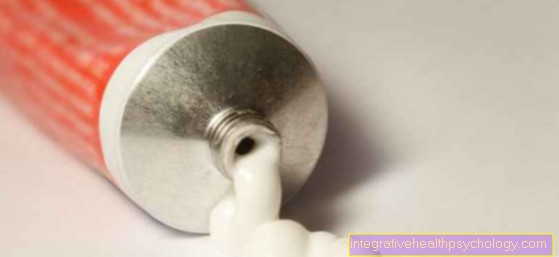





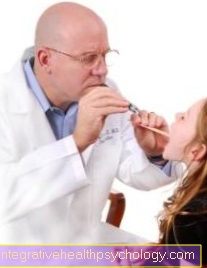


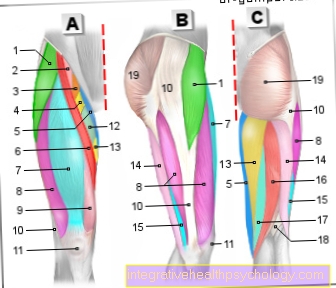




.jpg)


